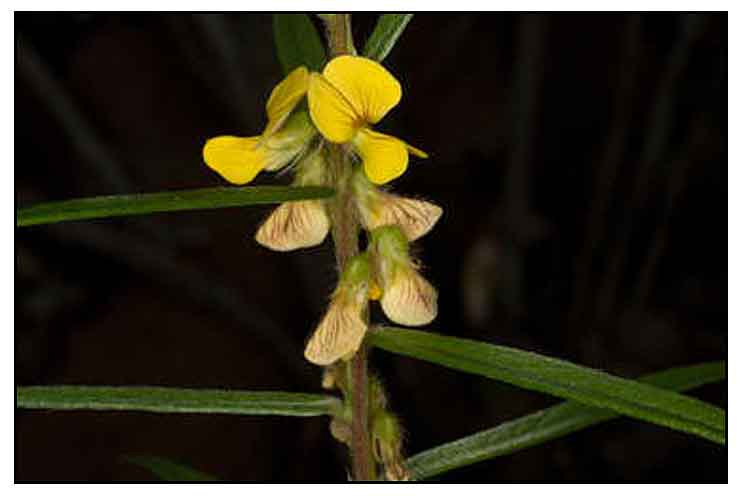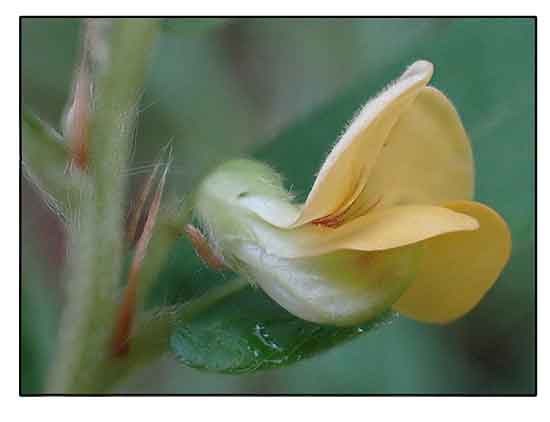 General info General info
- Eriosma is a genus of flowering plants in the family Fabaceae, containing over 150 accepted species, and widespread in the tropics.
Botany
• Katil is a annual or perennial, slender, erect, woody, little branched, and densely hairy plant. Stems are 30 to 50 centimeters. Leaflets are simple, linear-ligulate, and 2.5 to 5 centimeters in length. Flowers are yellow, 1 to 2, and borne on leaf axils. Pods are oblong, about 2 centimeters in length, and densely hairy.
• Herbs, perennial, erect, 12-50 cm tall. Root tuber fusiform to globose, succulent. Stems densely villous. Leaves 1-foliolate; stipules linear to linear-lanceolate, 4-8 mm, hairy, persistent; petiolule ± absent; blade lanceolate, 1.5-7 × 0.4-1.5 cm, abaxial surface shortly villous, adaxial surface and margins sparsely villous, base rounded or nearly cordate, apex obtuse or acute. Raceme axillary, extremely short, 1- or 2-flowered; bracts linear. Calyx campanulate, 3-5 mm, 5-lobed, brown villous. Corolla pale yellow; standard obovate, base with 2 pendulous oblong auricles; wings obovate-oblong, auriculate on one side; keel shorter than wings, obovate-oblong. Ovary densely long hirsute; style inflexed, glabrous. Legume rhomboid-elliptic or oblong, 8-10 × 5-6 mm, black when mature, hirsute. Seeds 2, black, small, reniform; hilum linear, almost up to seed length; funicle at one end of hilum. (Flora of China)
Distribution
- Native to the Philippines.
-
In open grasslands, chiefly at medium altitudes, ascending to 2,000 meters in Cagayan, Isabela, Bontoc, Lepanto, Benguet, and Nueva Vizcaya Provinces in Luzon; in Semirara; in Culion; and in Mindanao.
- Also native to Assam, Borneo, Cambodia, China South-Central, China Southeast, East Himalaya, Hainan, India, Jawa, Laos, Lesser Sunda Is., Malaya, Maluku, Myanmar, Nepal, New Guinea, Northern Territory, Queensland, Sulawesi, Taiwan, Thailand, Tibet, Vietnam, Western Australia. (9)
 Constituents Constituents
- Grain with the husk yields albuminoids, starch, oil, ash, and phosphoric acid.
- Study of hexane and dichloromethane extract of roots yielded eight new prenylated flavonoids, khonklonginols A-H (1-8), together with six known compounds including five flavonoids: lupinifolinol, dehydrolupinifolinol, flemichin D, eriosemaone A, and lupinifolin, and one lignan, yangambin. (see study below) (1)
- Roots yielded six prenylated flavonoids together with 12 known compounds.
- Hexane, dichloromethane and methanol extracts of roots yielded seven flavonoids, trans-p-coumaric acid ester, along with 12 compounds identified as 3-epilupinifolinol (•), 3-epikhonklonginol C (•), 2′-hydroxylupinifolinol (•), 2,5,2,4-tetrahydroxy-6″,6″-dimethylpyrano(2″,3″:7,6)-8-(3‴,3‴-dimethylallyl) flavone (•), (2R,3R,2‴R)-3,5,2‴-trihydroxy-4-methoxy-6″,6″-dimethylpyrano(2″,3″:7,6)-8-(3‴-methylbut-3‴-enyl) flavanone (•), 2‴,3‴-epoxy-khonklonginol A (•), 6,7-dimethoxy-5,2′,4′-trihydroxyisoflavone (•), octaeicosanyl-trans-p-coumarate, khonklonginol A (•), lupinifolinol (•), flemichin D (•), 7-O-methyltectorigenin, tectorigenin (•), genistein (•), kaempferol (•), 2′,4′,5,7-tetrahydroxy-6-methoxyisoflavone, kaempferol-7-O-β-d-glucopyranoside (•), genistein-7-O-β-d-glucopyranoside, genistin, astragalin (•) and cajanol (•). (10)
Properties
- Seeds are anti-diarrheal, astringent, diuretic, and tonic.
- Studies have suggested cytotoxic, antibacterial, antimycobacterial, antioxidant, antidiarrheal properties.
Parts used
Grain, seeds, roots.
 Uses Uses
Edibility
- In some regions of India, E. chinense is considered an edible tuberous legume.
- Roots used as vegetable by people of northern Australia and Northeast India.
- Tubers are eaten raw, cooked, or roasted.
Folkloric
- Decoction of grain used for scrofula.
- Decoction of grain, with powdered pepper added, is given for diarrhea.
- Powder of seeds applied to the skin to check cold sweats.
- Decoction of grain given to women during parturition to promote discharge of the lochia.
- Also used in leucorrhea and a variety of menstrual derangements.
- In India, seeds used for tonic, diuretic, and astringent properties.
- In Africa, sees used for wound healing.
- In North East India, roots used by tribal people for treatment of diarrhea.
(7)
- In Myanmar, decoction of seeds used for treatment of scrofula, diarrhea, leucorrhea and menstrual derangements. (10)
Studies
• Cytotoxic / Antimycobacterial / Roots: Study of extracts of roots yielded 8 new prenylated flavonoids, five known flavonoids and one lignan. The compounds were evaluated against small-cell lung and oral epidermal carcinoma human cell lines as well as antimycobacterial activity against M. tuberculosis H37Ra. Compound 1,2, 9 showed inhibitory activity against NCI-H187 (small cell lung carcinoma); compound 9 was most active against the KB (oral epidermal carcinoma. (1)
• Isoflavoid Extract / Extraction / Anti-Inflammatory: An invention describes Eriosema chinense isoflavoid extract and its extraction method. Extract was reported to be bacteria-resistant, anti-inflammatory, cough-relieving and sputum-resolving. (5)
• Antidiarrheal / Lupinifolin / Roots: Study evaluated an ethanol extract and various fractions for antidiarrheal effect in a castor oil-induced diarrhea model. A chloroform fraction showed the highest antidiarrheal effect, followed by the ethanol extract and lupinifolin. The antidiarrheal effect may be attributed to anti-motility and antisecretory effects with potential antibacterial activity. (7)
• Antimicrobial / Antioxidant / Flavonoids: Study of roots yielded six prenylated flavonoids together with 12 known compounds.
Seven isolates and derivatives were evaluated for antimicrobial and antioxidant activities. The presence of free phenolic OH and lipophilic prenyl groups are crucial for potent antimicrobial activity and the presence of free phenolic OH group is required for strong radical scavenging activity. (8)
• Antidiarrheal / Eriosematin E / Roots: A prenylated flavanone, eriosematin E, isolated from the roots, exhibited significant antidiarrheal activity. Maximum effective dose of eriosematin E was 10mg/kg p.o., inhibiting peristaltic index (small intestinal transit) and reducing intestinal fluid volume of castor oil induced and PGE2 induced enteropooling models. Antidiarrheal activity was attributed to its antisecretory and antioxidant potential.(10) (11)
• Antidiarrheal / Enteropathogenic E. coli-Induced Infectious Diarrhea / Roots: Study evaluated the potential of roots from E. chinense against enteropathogeic Escherichia coli-induced infectious diarrhea. Results showed significant antidiarrheal potential of the root extract and chloroform fraction. There was also significant restoration of altered antioxidant and electrolyte status and reactivated the Na+/K+-ATPase and prevented epithelial tissue damage. The effect was attributed to inhibition in intestinal secretion, nitric oxide production, and reactivation of NaKATPase. (12)
• Eriosematin E / Enteropathogenic E. coli-Induced Diarrhea: Study evaluated the potential of eriosematin E (ECM) isolated from roots of Eriosema chinense against enteropathogenic E. coli (EPEC) induced diarrhea. ECM was isolated from bioactive chloroform fraction of E. chinense. Results showed significant antidiarrheal potential at 5 and 10 mg/kg p.o., as evidenced by higher density of stools. The ECM also significantly increase the level of WBC, Hb, platelets and restored the altered antioxidants, pro-inflammatory cytokines (IL-ß and TNF-α) status and reactivated the suppressed NaKAtPase activity. Results were attributed to decline in levels of cytokines, inhibition of NO production, and reactivation of NaKATPase resulting in reduced intestinal secretion. (13)
• Antidiarrheal Mechanism of Eriosematin E Against Shigella flexneri Root: Study evaluated the potency of root extract of E. chinense (EEC), its bioactive chloroform fraction (CEC) and eriosmatin E (ECM) against Shigella-flexneri-induced sub-chronic model of infectious diarrhea. In vitro, ECM exhibited antibacterial activity, followed by CEC and EEC. In vivo. in induced diarrhea in mice, EEC and ECM showed more effective protection. There was also significant restoration of altered antioxidant, pro-inflammatory cytokines (IL-1ß and TNFα) expression, electrolyte balance, Na+/K+-ATPase activity, with histopathologic support. Eriosematin E inactivated the protease activity of SepA, a protein secretd by Shhigella, which is responsible for disruption of epithelial barrier integrity. Results confirmed the role of Eriosematin E in the treatment of Shigella flexneri-induced infectious diarrhea. (15)
• Antituberculosis Activity: In a study of Southeast Asian medicinal plants with anti-TB activity, hexane, dichloromethane, and methanol extracts of E. chinense roots yielded khonklonginal A, B, F, and H (1, 2, 6, and 8), lupinifolinol (9). dehydrolupinifolinol (10), flemichin D (11), eriosemaone A (12), lupinifolin (13). Crude hexane extract showed anti-TB activity against H37Ra strain with MIC value of 50 µg/ml using MABA. Compounds 10, 11, 12, and 13 exhibited good activity against H37Ra strain with MICs of 12.5 µg/ml. Compounds 1, 8, and 9 exhibited moderate activity with MIC value of 25 µg/ml. Compounds 2 and 6 showed activity with MIC values of 50 and 100 µg/ml, respectively. (16)
Availability
Wild-crafted.
|

![]()






